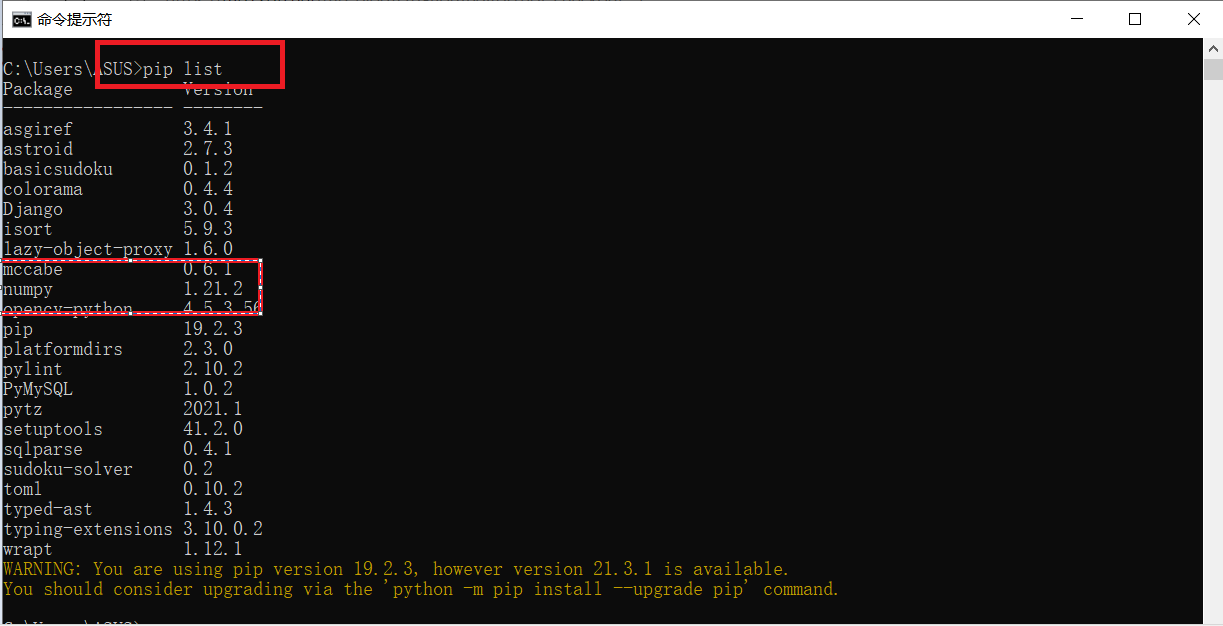install
1. Open cmd as an administrator

2. Enter the command to install numpy
pip insatll numpy
3. Use the following command to check whether the installation is successful
pip list

Create numpy
Data creation
Create using array
array syntax
""" numpy.array(object, dtype = None, copy = True, order = None, subok = False, ndmin = 0) """ import numpy as np #Create a one-dimensional array using array list01 = [1,2,3,4] np01 = np.array(list01) print(np01) print(type(np01)) #Creating a two-dimensional array using array list02 = [[1,2,3,4],[5,6,7,8]] np02 = np.array(list02) print(np02) print(type(np02)) #Create a 3D array using array list03 = [[[1,2,3,4],[5,6,7,8],[9,10,11,12]]] np03 = np.array(list03) print(np03) print(type(np03))
Understanding of dimension
Use of array parameters
| parameter | Parameters and description |
|---|---|
| Object | Any sequence type |
| dtype | Required data type of array, optional. |
| copy | Optional. The default value is true. Whether the object is copied. |
| order | C (by row), F (by column), or A (any, default). |
| subok | By default, the returned array is forced to be a base class array. If true, the subclass is returned. |
| ndimin | Specifies the minimum dimension of the returned array. |
# Object Any sequence type
tuple01 = (1,2,3)
list01= [1,2,3]
set01 = {5,6,7}
dict01 ={"Zhang San":10,"Li Si":20}
np01= np.array(dict01)
print(np01)
#dtype Required data type of array, optional.
list01 = [1,2,3]
np01= np.array(list01,dtype=float)
print(np01)
"""
explain np02 yes np01 The two are different objects
therefore np02 and np01 Different data
"""
list01 = [1,2,3]
np01= np.array(list01)
np02=np.array(np01,copy=True)
np02[0]=10
print(np01)
print(np02)
"""
You can see that the data is the same, indicating np02 and np01 Is the same object
"""
list01 = [1,2,3]
np01= np.array(list01)
np02=np.array(np01,copy=False)
np02[0]=10
print(np01)
print(np02)
#Since the order effect is not obvious and is not commonly used, it is used here as an understanding
#subok By default, the returned array is forced to be a base class array. If true, the subclass is returned.
#Matrix is a matrix. I'll explain it in detail later. I'll reuse it first
np01 = np.matrix('1 2 7; 3 4 8; 5 6 9')
print(type(np01))
print(np01)
np02 = np.array(np01, subok=True)
np03 = np.array(np01, subok=False)
print(type(np02)) #< class' numpy. Matrix '> if true, returns the matrix
print(type(np03)) #< class' numpy. Ndarray '> if it is False, it is forced to change to array
#ndimin Specifies the minimum dimension of the returned array.
list01 = [1,2,3]
np01= np.array(list01,dtype=float,ndmin=3)
print(np01)
Create with orange
Let's review the following range function """ range(start,stop,step) Function to create a list of integers 1.Don't write start,The default starts at 0 2.Left open right close 3.step Step size, not written, default is 1 """ for i in range(10): print(i)
""" arange(start,stop,step,dtype) 1.Don't write start,The default starts at 0 2.Left open right close 3.step Step size, not written, default is 1 """ #One dimensional array a = np.arange(10) #[0 1 2 3 4 5 6 7 8 9] a = np.arange(2,10) #[2 3 4 5 6 7 8 9] a = np.arange(1,10,2) #[1 3 5 7 9] a = np.arange(1,10,2,dtype=float) print(a) #Two dimensional array #Remember that the previous 12 must meet 3 * 4 np01 = np.arange(12).reshape(3, 4) print(np01)
Creating arrays using random
Common random functions
| function | describe |
|---|---|
| np.random.random(size) | Generate random numbers between 0 and 1 |
| np.random.randint(low,high=None,size=None,dtype="1") | Generate random integers |
| np.random.randn(d0,d1,d2,d3.........) | Generate a standard normal random number (expected 0, variance 1) |
| np.random.normal(loc,scale,size) | Generate normal distribution (specify expectation and variance) |
| np.random.uniform(low,high,size) | Generate uniformly distributed random numbers |
| np.random.shuffle() | Random disorder order |
| np.random.seed() | Set random number seed |
| np.random.sample(size) | Generate random floating point numbers |
# np.random.random() generates random numbers between 0 and 1 #Create a one-dimensional array size to generate several data, which can be written directly to 4 np01= np.random.random(size=4) #[0.13475357 0.8088961 0.52055803 0.49706622] #Create a two-dimensional array size=(3,4) 3 rows and 4 columns available () and [], the effect is the same np01= np.random.random((3,4)) #Create two three-dimensional arrays, three rows and four columns np01= np.random.random((2,3,4)) print(np01)
""" np.random.randint(low,high=None,size=None,dtype="1") Generate random integers low:start high=None : end size: length dtype data type,The default is int32 no01.dtype attribute 1.Left open right close 2.Don't write low The default is 0 """ #Create a one-dimensional array np01= np.random.randint(1,11,10)#1-10 #Create a 2D array np01= np.random.randint(1,11,(3,4))#1-10 #Create 3D array np01= np.random.randint(1,11,(2,3,4))#1-10 print(np01)
#Create a standard normal distribution #One dimensional array np01=np.random.randn(4) #Two dimensional array np01=np.random.randn(2,4) #3D array np01=np.random.randn(3,2,4) print(np01)
""" np.random.normal(loc,scale,size)Generate normal distribution(Specify expectation and variance) loc: Expected, default 0 scale: Variance, default 1.0 size: length """ np01= np.random.normal(size=5) np01= np.random.normal(loc= 2,scale=3,size=5) np01= np.random.normal(size=(2,3,5)) print(np01)
""" np.random.uniform(low,high,size) Generate uniformly distributed random numbers low: Do not write. The default is 0, high: ending, : length 1.Left open right close """ np01= np.random.uniform(size= 4)#The four data hardly differ much and are relatively uniform np01= np.random.uniform(size= (2,4)) np01= np.random.uniform(high=3) print(np01)
""" np.random.shuffle(ArrayLike)Random disorder order """ np01 = np.array([2,5,6,7,3]) print(np01) np.random.shuffle(np01) print(np01)
""" np.random.seed()Set random number seed The number selected from each pile of seeds will not change. Selecting random seeds from different piles is different every time. If you want to get the same random number every time, you need to call it every time before generating a random number seed() """ np.random.seed(1) np01= np.random.randint(1,10,size= 5) np.random.seed(1) np02= np.random.randint(1,10,size = 5) print(np01) print(np02)
""" np.random.sample(size) Generate random floating point numbers """ np01= np.random.sample(size=2) print(np01) np02= np.random.sample(size=(2,3)) print(np02)
Creating arrays using zeros
numpy.zeros(shaps,dtype=float,order="C") #Creates an array of the specified size, which is filled with 0
""" numpy.zeros(shaps,dtype=float,order="C") #Creates an array of the specified size, which is filled with 0 shaps:dimension dtype: data type order: By row by column """ np01= np.zeros(5) #[0. 0. 0. 0. 0.] np01= np.zeros(5,dtype="int32") #[0 0 0 0 0] np01= np.zeros((2,5),dtype="int32") """ [[0 0 0 0 0] [0 0 0 0 0]] """ print(np01)
Creates a multidimensional array of specific shapes
| function | describe |
|---|---|
| np.zeros((3, 4)) | Create 3 × An array whose elements of 4 are all 0 |
| np.ones((3, 4)) | Create 3 × An array whose elements of 4 are all 1 |
| np.empty((2, 3)) | Create 2 × 3. The value in the empty data is not 0, but an uninitialized garbage value |
| np.zeros_like(ndarr) | Create an array with all 0 elements in the same dimension of ndarr |
| np.ones_like(ndarr) | Create an array with all 1 elements in the same dimension of ndarr |
| np.empty_like(ndarr) | Create an empty array with ndarr the same dimension |
| np.eye(5) | This function is used to create a 5 × 5 matrix, diagonal is 1, and the rest is 0 |
| np.full((3,5), 10) | Create 3 × The elements of 5 are all arrays of 10, and 10 is the specified value |
np01= np.ones((2,5),dtype="int32") np01= np.empty((2,5),dtype="int32") print(np01)
list01= [
[1,2,3],
[4,5,6]
]
np01= np.array(list01)
print(np01.shape)
np02= np.zeros_like(np01,dtype=float)
print(np02)
print(np02.shape)# np.eye(5) this function is used to create a 5 × 5 matrix, diagonal is 1, and the rest is 0 np01= np.eye(5) print(np01)
# np.full((3,5), 10) create 3 × The elements of 5 are all arrays of 10, and 10 is the specified value #10 is specified. You can specify any value np01= np.full((3,5),5) print(np01)
Creating arrays using linspace
np.linspace(start, stop, num=50, endpoint=True, retstep=False, dtype=None)
| parameter | describe |
|---|---|
| start | Starting value of the sequence |
| stop | The termination value of the sequence. If endpoint=True, it proves that the array is contained in the sequence |
| num | The number of generated samples is 50 by default |
| endpoint | If true, stop is included, otherwise it is not included |
| retstep | If retstep=Ture, the generated array will display the spacing, otherwise it will not be displayed |
| dtype | data type |
""" np.linspace(start, stop, num=50, endpoint=True, retstep=False, dtype=None) """ np01= np.linspace(1,10,5)#From 1-10, 5 data are generated np01= np.linspace(1,10,5,endpoint=True)#Include 10 np01= np.linspace(1,10,5,endpoint=False)#Exclude 10 np01= np.linspace(1,10,5,retstep=True)#Display spacing np01= np.linspace(1,10,5,dtype="int32") print(np01)
Create an array using logspace
np.logspace(start,stop,num=50,endpoint=Ture,base=10.0,dtype=None)
| parameter | describe |
|---|---|
| start | Starting value of the sequence |
| stop | The termination value of the sequence. If endpoint=True, it proves that the array is contained in the sequence |
| num | The number of generated samples is 50 by default |
| endpoint | If true, stop is included, otherwise it is not included |
| base | The base of log. The default value is 10.0 |
| dtype | data type |